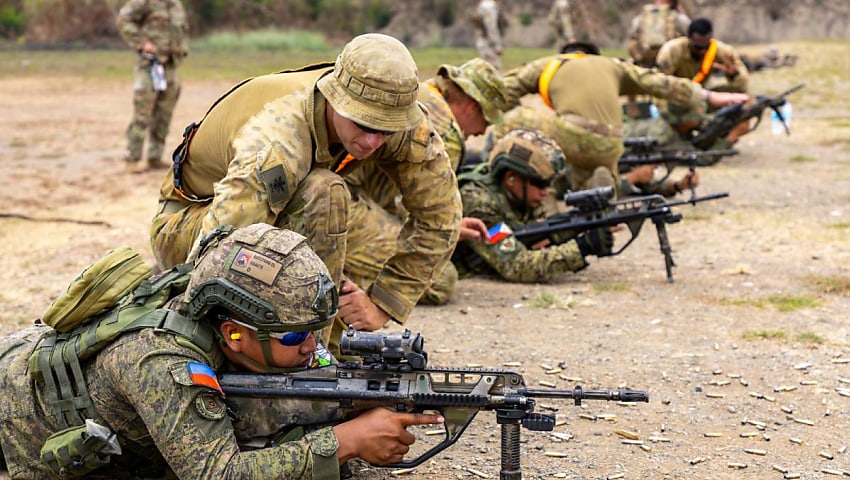More than 17,600 Australian, Philippine, and US soldiers have trained together during Exercise Balikatan 2023 in the Philippines.
To continue reading the rest of this article, please log in.
Create free account to get unlimited news articles and more!
A small contingent of soldiers from the 6th Battalion, Royal Australian Regiment, deployed to the southern island region of Maguindanao as part of the six-week Joint Australian Training Team – Philippines program (JATT-P).
Australian teams undertook “shoulder to shoulder” (Balikatan) training in marksmanship, combat shooting, reconnaissance and combat first aid before moving north and attaching to the AFP 7th Division and the US Army 1st/27th Infantry Division for the main exercise.
Platoon Commander Lieutenant Nicholas Elks said training soldiers of the Armed Forces of the Philippines (AFP) in a region that sees active conflict was an eye-opening and worthwhile experience.
“Knowing that the soldiers we trained had come directly off combat operations within their own region and potentially going back into conflict made it personally rewarding to provide them with useful skills for practical application,” LT Elks said.
“I think it also homed in on the value of the training we do back in Australia and the real-life application of those skills in the near region.
“(After joining the US Army division) the expeditionary nature of the exercise has been great, to get on the ground in different environments and conduct realistic combined arms training with artillery, engineers, and aircraft.
“After learning from one another, we can now adapt how we operate to work best together in the future.”
Lance Corporal Corbin Pett said the training team adapted coaching styles to suit the AFP soldiers and was impressed by the level of combat shooting they achieved.
“We picked up on some basic Tagalog and applied their catch words to help communication. By the end of the training package, they were executing battle lines with multiple threats and doing really well,” LCPL Pett said.
“The soldiers were so eager to learn and very receptive — almost like sponges — to training that we delivered.
“We were lucky the AFP conducted jungle training for us on how to survive: tactics, cooking, and even catching cobras to drink their blood … those guys are hard core.
“They are definitely superior in the jungle environment, so we picked up little tricks and I think next time we go to Tully we will be fine.
“(After joining the US Army division) to be in the Black Hawks and the Chinooks for the air assaults was amazing. It was a great experience in offensive operations.
“It was also good to recognise how well we performed, using our tactics, the element of surprise and individual discipline as a smaller but effective force.”
More than 1,400 service members from the US and Philippines took part in the combined joint littoral live-fire exercise in Zambales province.
Personnel were tasked with detecting, identifying, targeting, and engaging a decommissioned Philippine Navy corvette using coordinated fire from a variety of ground and air-based weapons systems.
Bilateral weapons systems included US and Philippine artillery, High-Mobility Artillery Rocket Systems, Avenger air defence systems, AH-64 Apache attack helicopters, Philippine Air Force FA-50 Golden Eagle fighter-attack aircraft, F-16 Fighting Falcons, US Marine F-35B Joint Strike Fighters, and a US Air Force Special Operations Command AC-130 Spectre gunship.
A pair of High Mobility Artillery Rocket System launchers used for the exercise fired six times at the corvette over the horizon, reportedly missing each time before it was sunk by combined artillery fire.
US Marine Corps Forces Pacific Commander and US director for the exercise, Lieutenant General William Jurney said a focus point in Balikatan 2023 was bilateral integration of command and control, sensors and multi-domain fires.
“This training increased the exercise’s realism and complexity, a key priority shared between the Armed Forces of the Philippines and the US military,” he said.
“Together we are strengthening our capabilities in full-spectrum military operations across all domains.”
Armed Forces of the Philippines Education, Training and Doctrine Command Commander and Balikatan 2023 exercise director Major General Marvin L Licudine said the training successfully advanced combined military modernisation and capability development in a complex and realistic training environment.
“This significant activity demonstrated new potential and revitalised the strength of our militaries while we continuously forge an ironclad alliance,” he said.
“This event enhanced the interoperability of the Philippines and US forces in conducting combined joint operations utilising both countries’ army, navy, and air force assets in conducting maritime security and territorial defence.”

 Login
Login







